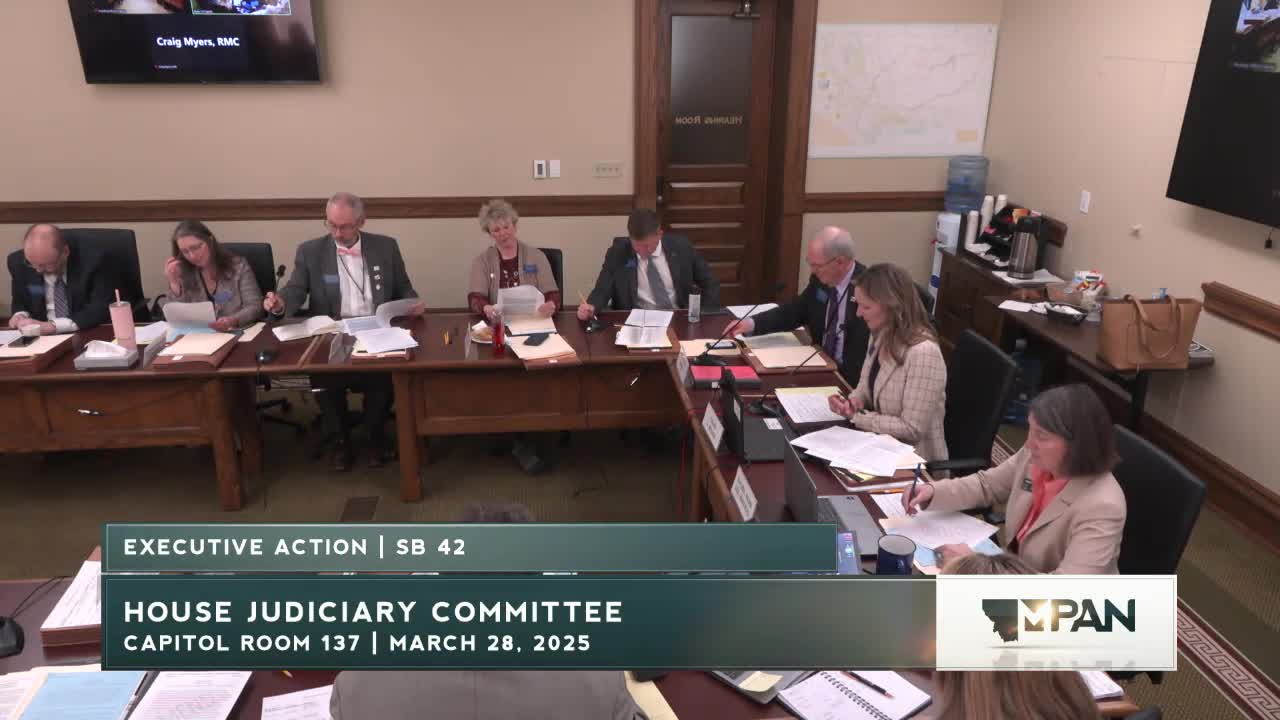Montana lawmakers debate party affiliation in nonpartisan judicial races
March 28, 2025 | 2025 Legislature MT, Montana
This article was created by AI summarizing key points discussed. AI makes mistakes, so for full details and context, please refer to the video of the full meeting. Please report any errors so we can fix them. Report an error »

In a recent meeting of the Montana House Judiciary Committee, lawmakers engaged in a heated discussion regarding proposed amendments to Senate Bill 42, which seeks to alter the way judicial candidates are presented on ballots. The primary focus was on the inclusion of party affiliations for judicial candidates, a move that has sparked significant debate about the potential implications for judicial impartiality and election integrity.
The committee members expressed concerns about the ambiguity surrounding the implementation of the bill. Some representatives questioned whether independent candidates would appear on both Democratic and Republican ballots, or if they would be relegated to a separate ballot altogether. This uncertainty raised alarms about how voters would perceive and interact with judicial candidates during elections.
Representative Griffith voiced strong opposition to the bill, arguing that it fails to address the underlying issues plaguing judicial elections, particularly the influence of money from partisan sources. He emphasized that simply adding party labels does not enhance voter information and could lead to biases in judicial decision-making. Griffith's sentiments were echoed by other committee members who expressed skepticism about the bill's ability to foster a fair electoral process.
Conversely, some representatives supported the bill, asserting that it could bring necessary reforms to a judicial system perceived as increasingly partisan. They argued that the current system is not satisfactory for either side of the political spectrum and that changes are essential to restore balance and public trust in the judiciary.
The committee ultimately voted on the amendment, passing it with a 12-8 majority. Following this, the amended Senate Bill 42 was also concurred in, indicating a step forward in the legislative process despite ongoing concerns about its implications.
In addition to Senate Bill 42, the committee also discussed House Bill 838, which aims to revise laws related to party affiliation in nonpartisan judicial races. This bill, too, faced scrutiny, with representatives debating the ethical implications of party affiliations in judicial elections and the potential for increased partisanship.
As the discussions unfolded, it became clear that the committee is grappling with the complex intersection of judicial independence and electoral transparency. The outcomes of these legislative efforts could significantly impact the future of judicial elections in Montana, raising questions about how best to balance the need for informed voters with the imperative of maintaining an impartial judiciary. The committee's next steps will be closely watched as they navigate these contentious issues.
The committee members expressed concerns about the ambiguity surrounding the implementation of the bill. Some representatives questioned whether independent candidates would appear on both Democratic and Republican ballots, or if they would be relegated to a separate ballot altogether. This uncertainty raised alarms about how voters would perceive and interact with judicial candidates during elections.
Representative Griffith voiced strong opposition to the bill, arguing that it fails to address the underlying issues plaguing judicial elections, particularly the influence of money from partisan sources. He emphasized that simply adding party labels does not enhance voter information and could lead to biases in judicial decision-making. Griffith's sentiments were echoed by other committee members who expressed skepticism about the bill's ability to foster a fair electoral process.
Conversely, some representatives supported the bill, asserting that it could bring necessary reforms to a judicial system perceived as increasingly partisan. They argued that the current system is not satisfactory for either side of the political spectrum and that changes are essential to restore balance and public trust in the judiciary.
The committee ultimately voted on the amendment, passing it with a 12-8 majority. Following this, the amended Senate Bill 42 was also concurred in, indicating a step forward in the legislative process despite ongoing concerns about its implications.
In addition to Senate Bill 42, the committee also discussed House Bill 838, which aims to revise laws related to party affiliation in nonpartisan judicial races. This bill, too, faced scrutiny, with representatives debating the ethical implications of party affiliations in judicial elections and the potential for increased partisanship.
As the discussions unfolded, it became clear that the committee is grappling with the complex intersection of judicial independence and electoral transparency. The outcomes of these legislative efforts could significantly impact the future of judicial elections in Montana, raising questions about how best to balance the need for informed voters with the imperative of maintaining an impartial judiciary. The committee's next steps will be closely watched as they navigate these contentious issues.
View full meeting
This article is based on a recent meeting—watch the full video and explore the complete transcript for deeper insights into the discussion.
View full meeting
